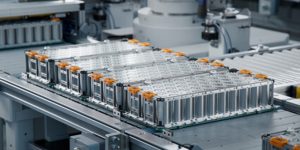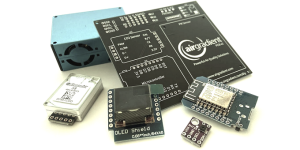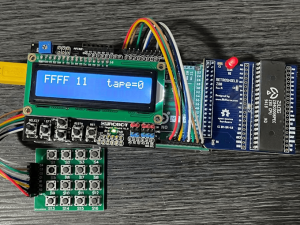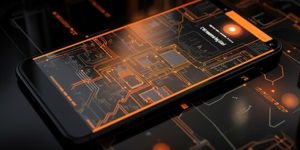In 1950 the engineer Russell A. Kirsch led a project team at US National Bureau of Standards (now National Institute of Standards and Technology) for developing the first programmable computer in America, the SEAC (Standards Electronic Automatic Computer) to experiment algorithms for the National Government Agencies.
SEAC used only 747 vacuum tubes (a small number for the time) eventually expanded to 1500 tubes. It had 10,500 germanium diodes which performed all of the logic functions. The machine used 64 acoustic delay lines to store 512 words of memory. Every word being 45 bits in size and The clock rate was kept low (1 MHz). Therefore the SEAC would be used to solve more than 50 different unrelated scientific problems for a variety of users.
In 1957 laboratories and commercial establishments used the computers, beacause they had to digitalise documents by the character recognition logic. This required an input device that could transform a picture of a character into a form suitable for storage in the memory of a computer. The first Image Scanner for SEAC was born. It used a rotating drum and a photomultiplier to sense reflections from a small image mounted on the drum. A mask interposed between the picture and the photomultiplier tessellated the image into discrete pixels. A staticizer connected to the SEAC memory enabled a stored image which appeared on a cathode ray oscilloscope. This made it possible for the researchers to see what the computer “saw”. Nonetheless the first pictures ever scanned and redisplayed before represented a feel for the age and maturity of the image processing field was. It was the Kirsch‘s newborn son.
On the other hand, the limited memory capacity of SEAC dictated that the scanner represent images as rectangular arrays of size 176 x 176 square binary pixels, each of size 0.25 mm x 0.25 mm.



















 Le estati sempre più torride portano con sé una serie di sfide per le batterie delle auto elettriche, causando potenziali malfunzionamenti, riduzioni della durata e persino danni permanenti. Questi problemi non solo peggiorano le prestazioni del veicolo, ma ne compromettono anche l'affidabilità generale. Proprio come il freddo, anche il caldo estremo rappresenta una minaccia significativa per le batterie al litio, cuore pulsante delle auto elettriche moderne. Le alte temperature possono influenzare negativamente qualsiasi dispositivo tecnologico, comprese le auto elettriche, esponendole a rischi di surriscaldamento quando vengono lasciate al sole per lunghi periodi. Questa situazione è particolarmente critica in un contesto in cui la diffusione delle vetture elettriche rappresenta una delle principali sfide e opportunità per la mobilità sostenibile. Tuttavia, il […]
Le estati sempre più torride portano con sé una serie di sfide per le batterie delle auto elettriche, causando potenziali malfunzionamenti, riduzioni della durata e persino danni permanenti. Questi problemi non solo peggiorano le prestazioni del veicolo, ma ne compromettono anche l'affidabilità generale. Proprio come il freddo, anche il caldo estremo rappresenta una minaccia significativa per le batterie al litio, cuore pulsante delle auto elettriche moderne. Le alte temperature possono influenzare negativamente qualsiasi dispositivo tecnologico, comprese le auto elettriche, esponendole a rischi di surriscaldamento quando vengono lasciate al sole per lunghi periodi. Questa situazione è particolarmente critica in un contesto in cui la diffusione delle vetture elettriche rappresenta una delle principali sfide e opportunità per la mobilità sostenibile. Tuttavia, il […] AirGradient è un'azienda che progetta e produce dispositivi per il monitoraggio della qualità dell'aria professionali, accurati e di lunga durata, open source e open hardware. Questi monitor possono essere utilizzati per il monitoraggio della qualità dell'aria sia domestica che esterna. I monitor della qualità dell'aria di AirGradient sono progettati per essere economici e personalizzabili e sono dotati di un codice completamente open source in modo che gli utenti possano apportare facilmente modifiche. La natura open hardware permette anche di costruire in completa autonomia il proprio dispositivo personalizzato. In questo articolo andremo a descrivere come realizzare una versione base di questo dispositivo. Introduzione I dispositivi di monitoraggio di AirGradient sono dotati di sensori che misurano diversi parametri della qualità dell'aria come […]
AirGradient è un'azienda che progetta e produce dispositivi per il monitoraggio della qualità dell'aria professionali, accurati e di lunga durata, open source e open hardware. Questi monitor possono essere utilizzati per il monitoraggio della qualità dell'aria sia domestica che esterna. I monitor della qualità dell'aria di AirGradient sono progettati per essere economici e personalizzabili e sono dotati di un codice completamente open source in modo che gli utenti possano apportare facilmente modifiche. La natura open hardware permette anche di costruire in completa autonomia il proprio dispositivo personalizzato. In questo articolo andremo a descrivere come realizzare una versione base di questo dispositivo. Introduzione I dispositivi di monitoraggio di AirGradient sono dotati di sensori che misurano diversi parametri della qualità dell'aria come […] Affascinato dall'idea di costruire un computer fai-da-te UT-88 degli anni '80 a 8 bit, Evgeny Adamenkov ha scelto di seguire un approccio più moderno, realizzando il suo remake con un Arduino Mega 2560, un RetroShield Z80, un display LCD 16x2 e una tastiera 4x4. Incuriosito dall'idea di costruire un computer fai-da-te UT-88 degli anni '80 a 8 bit, Evgeny Adamenkov ha optato per un approccio più moderno, realizzando il suo remake con un Arduino Mega 2560, un RetroShield Z80, un display LCD 16x2 e una tastiera 4x4. Questo progetto non solo preserva l'essenza del computer originale, ma introduce anche una maggiore facilità d'uso grazie alla programmabilità dell'Arduino. Evgeny ha eliminato la necessità di saldature complesse e componenti vintage, rendendo il […]
Affascinato dall'idea di costruire un computer fai-da-te UT-88 degli anni '80 a 8 bit, Evgeny Adamenkov ha scelto di seguire un approccio più moderno, realizzando il suo remake con un Arduino Mega 2560, un RetroShield Z80, un display LCD 16x2 e una tastiera 4x4. Incuriosito dall'idea di costruire un computer fai-da-te UT-88 degli anni '80 a 8 bit, Evgeny Adamenkov ha optato per un approccio più moderno, realizzando il suo remake con un Arduino Mega 2560, un RetroShield Z80, un display LCD 16x2 e una tastiera 4x4. Questo progetto non solo preserva l'essenza del computer originale, ma introduce anche una maggiore facilità d'uso grazie alla programmabilità dell'Arduino. Evgeny ha eliminato la necessità di saldature complesse e componenti vintage, rendendo il […] La robotica educativa rappresenta una delle più avvincenti e potenti modalità di apprendimento contemporaneo, in grado di integrare efficacemente i principi di STEM (Scienza, Tecnologia, Ingegneria e Matematica) nelle aule di tutto il mondo. In un'era dove le competenze digitali sono diventate imprescindibili, l'adozione di programmi di robotica educativa non solo arricchisce il bagaglio conoscitivo degli studenti, ma stimola anche la creatività, la capacità di problem solving e il lavoro di squadra. In questo articolo, esploriamo come la robotica educativa sta rivoluzionando l'insegnamento delle discipline STEM e delineando le sue potenzialità per il futuro dell'educazione. La robotica educativa coinvolge gli studenti in attività pratiche e interattive, permettendo loro di costruire, programmare e manipolare robot. Questo approccio hands-on favorisce un apprendimento […]
La robotica educativa rappresenta una delle più avvincenti e potenti modalità di apprendimento contemporaneo, in grado di integrare efficacemente i principi di STEM (Scienza, Tecnologia, Ingegneria e Matematica) nelle aule di tutto il mondo. In un'era dove le competenze digitali sono diventate imprescindibili, l'adozione di programmi di robotica educativa non solo arricchisce il bagaglio conoscitivo degli studenti, ma stimola anche la creatività, la capacità di problem solving e il lavoro di squadra. In questo articolo, esploriamo come la robotica educativa sta rivoluzionando l'insegnamento delle discipline STEM e delineando le sue potenzialità per il futuro dell'educazione. La robotica educativa coinvolge gli studenti in attività pratiche e interattive, permettendo loro di costruire, programmare e manipolare robot. Questo approccio hands-on favorisce un apprendimento […] Conosciamo tutti il giroscopio e la sua utilità negli smartphone? Si tratta di piccoli dispositivi che sono il vero futuro della tecnologia mobile. Questa breve guida ha lo scopo di offrire una panoramica dettagliata sull'importanza dei giroscopi negli smartphone, evidenziandone le funzionalità e gli utilizzi pratici. L'argomento è di grande interesse per gli appassionati di tecnologia e per coloro che desiderano comprendere meglio come le tecnologie avanzate migliorano la nostra vita quotidiana. I giroscopi sono strumenti tecnologici avanzati utilizzati per misurare e mantenere l'orientamento di un oggetto nello spazio. Basati sul principio della conservazione del momento angolare, i giroscopi rilevano i cambiamenti di orientamento rispetto a un asse fisso. Questi dispositivi sono costituiti da un rotore in rapida rotazione, il […]
Conosciamo tutti il giroscopio e la sua utilità negli smartphone? Si tratta di piccoli dispositivi che sono il vero futuro della tecnologia mobile. Questa breve guida ha lo scopo di offrire una panoramica dettagliata sull'importanza dei giroscopi negli smartphone, evidenziandone le funzionalità e gli utilizzi pratici. L'argomento è di grande interesse per gli appassionati di tecnologia e per coloro che desiderano comprendere meglio come le tecnologie avanzate migliorano la nostra vita quotidiana. I giroscopi sono strumenti tecnologici avanzati utilizzati per misurare e mantenere l'orientamento di un oggetto nello spazio. Basati sul principio della conservazione del momento angolare, i giroscopi rilevano i cambiamenti di orientamento rispetto a un asse fisso. Questi dispositivi sono costituiti da un rotore in rapida rotazione, il […]

